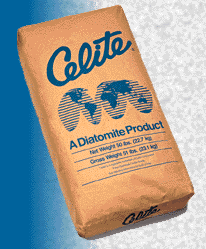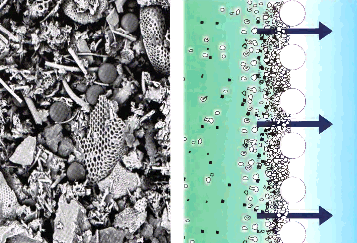How Filteraid Works
How do I know which type of filteraid to use?
In general, CELITE, diatomite (diatomaceous earth) has a more intricate particle shape and thus provides a more tortuous path for suspended particles to be trapped. HARBORLITE (expanded amorphous aluminum silicate) will usually handle similar filtration tasks but cannot always achieve the same removal efficiency. Fibra Cel, cellulose fiber is generally used in high temperature, highly alkaline environments where filter aid solubility would be a problem.
Why doesn't one grade of filteraid handle all applications?
Because filtering is basically a surface trapping phenomena (over simplified) and thus one always strives to use a filter aid that has a median pore size (the opening of the tortuous channels) just slightly smaller than the average particle size of the suspended matter that you are trying to remove. Diatomaceous Earth (CELITE, diatomite) has many grades to select from for the specific application.
Who is the manufacturer of CELITE, diatomaceous earth (diatomite)?
World Minerals Inc., of Santa Barbara, California is the largest manufacturer of diatomaceous earth in the world. see info@worldminerals.com
What is Diatomaceous Earth?
Diatomaceous Earth (also known as DE, diatomite and Kieselghur) is the fossil remains of plankton that died in the oceans millions of years ago and sank to the bottom to form deposits. Chemically it is predominantly silica, one of the most abundant minerals on the upper crust of our planet, earth!
FILTRATION "THEORY"
Filtration using Celite diatomite is a two step operation. First, a thin protective layer of filter aid, called the precoat, is built up on the filter septum by recirculating a filter aid slurry. After precoating, small amounts of filter aid (body feed) are regularly added to the liquid to be filtered. As filtering progresses, the filter aid, mixed with the suspended solids from the unfiltered liquid, is deposited on the precoat. Thus, a new filtering surface is continuously formed. The minute filter aid particles provide countless microscopic channels which entrap suspended impurities but allow liquid to pass through, without clogging.
An efficient, economical filter aid must:
1) have rigid intricately shaped, porous individual particles.
2) form a highly permeable, stable and incompressible cake
3) remove even the finest solids at high rates of flow
4) be chemically inert and essentially insoluble in the liquid being filtered.

Celite diatomite meets these requirements due to the wide variety of intricately shaped particles and inert composition which makes it practically insoluble in all but a few liquids.
Celite processes filter aid grades in a wide range of particle sizes to meet practically any industrial filtration requirement. The relative flow rates of these grades are determined by
a standard filtration test.
Celite 500, the finest Celite grade giving the highest clarity and lowest flow rate, is a natural diatomite which has been selectively quarried, dried, milled and air-classified. To make coarser, faster flow rate filter aids, Celite 500 is calcined and air-classified. These straight calcined grades are Celite 577, Standard Super-Cel and Celite 512. To obtain still
larger particles, a flux is added before calcination giving the flux-calcined or white grades of filter aids, which include those Hyflo Super-Cel to Celite 560, the coarsest.
In the use of filter aids the ability of the filter aid to remove small particles of suspended matter decreases as the particle size decreases, and thus the flow rate, increases. Conversely, as filter aid particle size and therefore the flow rate decreases, the ability of the filter aid to remove small particles of suspended , matter increases. The extent to which this takes place will depend very much on the type and particle size distribution of the non soluble solids being removed.
In most instances, the particle size range of non soluble solids is such that a fine grade of filter aid, down to the finest will improve clarity. If, however, a given filter aid grade will remove 100% of the suspended solids, a finer grade while giving a lower flow rate due to its finer structure, will not give increased clarity.
The selection of the proper filter aid grade is a compromise between high clarity and low flow rate, and lower clarity and higher flow rate. The best filter aid is that grade which provides the fastest flow rate while maintaining an acceptable degree of clarity, which must be determined and specified by the filter aid user.
For a given liquid, clarity of filtrate is governed principally by:
1) grade and amount of filter aid for body feed
2) grade and amount of filter aid for precoat
3) length of cycle
4) filtration rate
Desired clarity, or the amount of acceptable suspended solids in the filtrate, can be determined in a number of ways:
1) visual examination of a sample of filtrate
2) comparing a sample of filtrate with a standard
3) the use of electronic turbidity instruments
4) filtering a sample of filtrate on a fine while of black filter paper
5) chemical or biological analysis
6) gravimetric analysis.
It is extremely difficult to state the particle size of the solid that will be removed by any given grade of Celite. This depends upon the method used for measuring the particle size of
the contaminant, the type of liquid involved, the shape of the particle, filtration conditions and the particle characteristics. For example, a needle like particle might easily be removed if it approaches the filter cake sideways, while it could pass right through if it approaches on end. A compressible, soft particle might extrude its way through a filter cake, whereas a rigid particle of the same size and shape would not. Variations in pressure, vibration and air bubbles may also affect clarity.
An approximation of the degree of clarity obtainable by any one grade of filter aid can be gained by running filtration tests using proper techniques on a Buchner funnel. These tests will not be exact because in an actual filtration, as the cycle progresses, the filter cake tends to become partially plugged or "tightened" by the particles of suspended solids being removed. This tightening of the filter cake produces a filtrate of progressively higher clarity. It maybe advisable, therefore, if filtrate from the whole length of the cycle is blended, to consider average clarity, rather than spot clarities. Possibly, this may allow the use of a faster grade of filter aid.
THE FILTRATION SYSTEM
The essentials of a filter aid filtration system are shown in the drawing (below). These consist of the filter, the filter feed pump, tanks containing filter aid for precoating and body feed pump for continuous addition of filter aid. Note also the lines for filling the body feed tank and precoat tank with filtered liquid, and circulating clear or filtered liquid containing filter aid between the precoat tank and the filter. The system may also include a precoat circulating pimp and auxiliary lines for blowing back the filter heel to the feed tank, and for filling and recirculating wash liquid, as well as vent lines and lines for blowing the filter cake dry with air, inert gas or steam.
Continuous addition of filter aid (body feeding) is accomplished either by feeding filter aid as a slurry or by dry feeding. Slurry feeding is usually done with plunger or diaphragm pumps. If filtration is a batch process, the filter aid can be added directly to the batch as admix.
In the operation of a filtration system, the filter is first precoated by circulating a mixture of filter aid and clear or filtered liquid from the precoat tank through the filter and back to the precoat tank. This is continued until all the filter aid is deposited on the filter septum. The body feed injection system is then started and the filter is changed over, with minimum fluctuations in pressure, from precoating to filtering.
PRECOATING
The first step in the use of Celite is to build up a "precoat" of Celite filter aid on the filter septum. The purpose of the precoat is threefold:
1. To prevent the filter septum from becoming clogged by impurities, thus prolonging septum life.
2. To give immediate clarity.
3. To facilitate cleaning of the septum at the end of the cycle.
Precoating is accomplished by circulating a slurry of filter aid and filtered or clear liquid between the filter and the precoat tank. Since most of the filter aid particles are smaller than the openings in the septum, they must form the precoat by bridging these openings. These bridges can be upset by air bubbles, sudden changes in pressure, or vibrations, causing the filtrate to become turbid until the upsetting influences have been corrected. If flow distribution in the filter is good, the filter may be filled with clear precoat liquid and a concentrated slurry of filter aid may then be pumped or educted into the filter followed by recirculation.

AMOUNT OF PRECOAT
The amount of precoat should be from 10 to 20 lbs. of filter aid per 100sq. ft. of filter area, the greater amount being used when distribution of flow in the filter is poor, or in starting up new filters. If it is perfectly distributed, 10 lbs. (4.5 kg) of filter aid per 100 sq. ft. (9.29 sq. m) of filter area will give a precoat of approximately 1/16" (1.6 mm) in thickness. The use of baffles of precoating at a different rate may be necessary for an even precoat at lower precoat amounts. Precoat slurry concentration will depend primarily on the ratio of filter area to the liquid volume of the filter and piping. If the concentration is much below 0.3%, precoating may be difficult since the formation of the bridge depends partly on the "crowding" effect of the particles of Celite trying to get through the septum openings.
PRECOATING RATE
The precoat pumping rate will depend mainly on the viscosity of the liquid used. The rate should be sufficient to keep all the filter aid in suspension but should not be fast enough to cause erosion of precoat in the filter. For water, a typical rate is from 1 to 2 gals. per sq. ft. of filter area per minute (gsfm), or 40-80 liters per sq. m of filter area per minute. For viscous liquids, the rate may be as low as 5 gals. per sq. ft. per hour (gsfh), or 20 liters per sq. m per hour. A general rule for precoating is to precoat at that rate which gives a differential pressure of approximately 2 lbs./sq. in (13.8 kilopascals). For water, an upward velocity of at least 4 1/2 ft./min. (1.4 meters/min.) is required for proper filter aid suspension. The suspension of filter aid can be improved in the tank type, or pressure leaf filter, by recirculating part of the inlet flow from the top of the filter back to the precoat tank.
TROUBLESHOOTING
Precoating filtrate should clear up in 2 to 5 minutes. However, this does not mean the precoat is all in place. Continue precoating until the liquid in the filter shell is relatively clear. This usually takes place in 10 to 15 minutes at most. Lack of clarity of filtrate could be caused by any precoat erosion caused by too high a circulation rate; blinding of filter septum; insufficient precoat at top of leaves caused by too little circulation; tears in septum; old screens with worn and/or separated wires; leaks between septum and rum of leaf; worn gaskets between leaf discharge nipple and discharge manifold; wrinkles in septum; negative pressure on discharge manifold causing flashing inside the leaf.
www.filteraid.com
www.diatomite.com
www.beaverchemicals.com
Copyright © 2012, Beaver Chemicals Ltd. All rights reserved